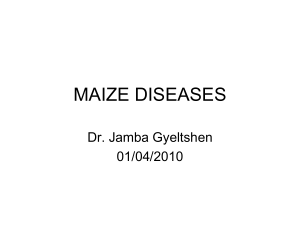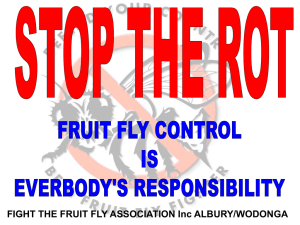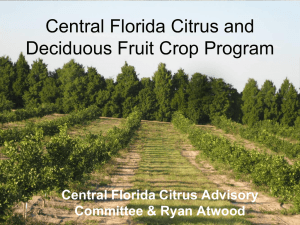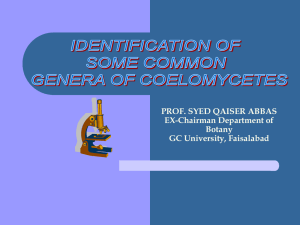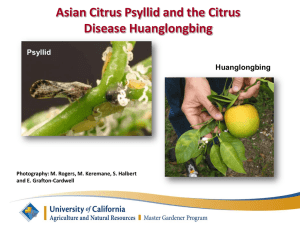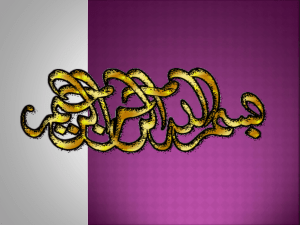E. australis
advertisement
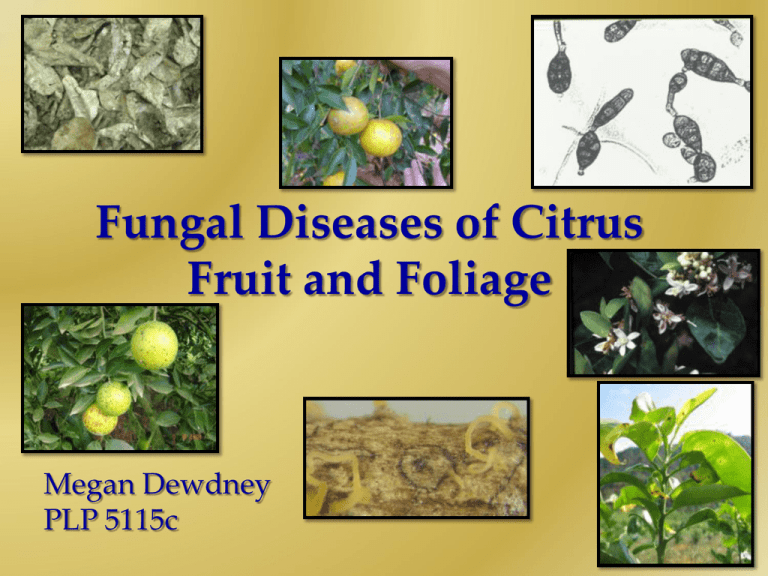
Fungal Diseases of Citrus Fruit and Foliage Megan Dewdney PLP 5115c Foliar Fungal Diseases to be Covered Alternaria Brown Spot (and leaf spot of rough lemon) Greasy spot Melanose Scab Diseases Postbloom Fruit Drop Black Spot Pseudocercospera Fruit and Leaf Spot Note on Terminology Many Ascomycete fungi have what is know as an anamorph and teleomorph Anamorph: asexual or imperfect stage Teleomorph: sexual or perfect stage Have separate names Fungi where no sexual stage has been identified are grouped into the ‘Fungi Imperfecti’ Synonym: Deuteromycte Some Basidiomycetes have also lost sexual stage Ex. Rhizoctonia spp. Alternaria Brown Spot Causal agent: Alternaria alternata Synonyms Alternaria citri and A. alternata pv. citri No known teleomorph Important disease on tangerines and tangelos 1903 First described in Australia on Emperor mandarin Alternaria Brown Spot cont. 1974 First identified in Florida Also found in South Africa, Turkey, Israel, Spain, Colombia and other countries Host specific toxin Isolates from tangerines and tangelos do not infect rough lemon except in rare circumstances Disease on rough lemon same organism with different toxin Considered separate pathotypes of A. alternata Alternaria alternata No sexual stage known Necrotrophic Conidia are small, thick walled, pigmented and multicellular The conidiophores are determinate and pigmented Conidia are borne in chains Hyphae penetrate host tissue directly; No appresorium Tissue Susceptibility Highly susceptible cultivars Dancy, Minneola, Orlando, Sunburst, Murcott, Nova and Lee Leaves susceptible from formation to when fully expanded and hardened Fruit are susceptible from petal fall to 5 cm (2 inch) in diameter Symptoms Alternaria Brown Spot Disease Cycle Caused by Alternaria alternata When are the Conidia Released? Conidia released by rain events or sudden changes in relative humidity In field trapping number of conidia in the air related to leaf wetness duration Number of airborne conidia not related to infection severity Timmer et al., 1988 Infection Conditions Optimum temperatures 23-27°C Can get infection between 17-32°C Infection can occur with as little as 4-6 hours of leaf wetness but disease severity increases with leaf wetness Canihos et al., 1999 Alternaria Brown Spot Disease Cycle Caused by Alternaria alternata Cultural Controls Disease-free nursery trees Careful choice of planting site Air drainage important Wider spacing No vigorous rootstocks No over-fertilization or over-watering Hedge in late March No overhead irrigation Fungicides Copper –Works well for fruit but not leaves Ferbam – Only moderately effective Strobulurins – Most effective but specific MOA Azoxystrobin Trifloxystrobin Pyraclostrobin First spray when spring flush ¼-1/2 full expansion; high inoculum another before full expansion or at petal fall Rest of the year maintain protective coating ALTER-RATER: A Forecasting System Weather-based point system to better time fungicide applications Points assigned based on: Rainfall and leaf wetness Average daily temperature Thresholds vary by cultivar susceptibility More information found at: http://edis.ifas.ufl.edu/ch183 The ALTER-RATER Suggested Threshold Scores Score 50 100 150 Situation Heavily infested Minneola, Dancy, Orlando, Sunburst; Many flatwood groves, east coast, and SW Florida. Moderately infested Minneola or Dancy, many Murcotts; Ridge and north Florida groves. Light infestations, any variety, mostly Ridge and north Florida groves. ALTER- RATER Daily Points Rain > 0.1 inch LW > 10 hr Avg daily Temp Assigned score + + 68-83 11 + + > 83 8 + + < 68 6 + _ 68-83 6 + _ > 83 4 + _ < 68 3 _ + 68-83 6 _ + > 83 6 _ + < 68 4 _ _ 68-83 3 _ _ > 83 0 _ _ < 68 0 Greasy Spot Causal agent: Mycosphaerella citri Anamorph: Stenella citri-grisea Anamorph synonym Cercospora citri-grisea Other similar diseases described around world but caused by other Mycosphaerella spp. Important disease on most types of citrus 1915 First described in Florida and Cuba Greasy Spot cont. Also occurs in Texas, the Caribbean, Central and South America, and parts of Asia Primary effect is to cause defoliation which can lead to decreases of yield and fruit size Up to 25% on sweet orange in Florida Up to 45% on grapefruit Mycosphaerella citri Loculoascomycete Pseudothecia up to 90 µm Found in leaf litter Ascospores fusiform and hyaline with one septum (2-3 x 6-12 µm) Stenella citri-grisea Conidia are pale olive brown, cylindrical with indistinct septae that can be in chains Two types of conidiophores Most common simple, smooth, dark and erect Rare, in clusters (fasciculate) found in necrotic areas on leaves Mycelium Epiphytic hyphae Highly branched Rough walls Olive brown color when young but darken with age and the walls become smooth Appressoria formed in stomatal chambers Mycelia within leaf grow intercellularly and are not very branched Tissue Susceptibility Highly susceptible cultivars Grapefruit, Pineapple, Hamlin, and Tangelos Less susceptible cultivars Valencia, Temple, Murcott and most tangerines Young and mature leaves susceptible to infection Immature fruit susceptible Symptoms Greasy Spot Disease Cycle Caused by Mycosphaerella citri Pseudothecia Maturation Moisture Mondal and Timmer, 2002 Pseudothecia Maturation Temperature Optimal Temperatures for Ascospore Production 28 °C = 82.4 °F Mondal and Timmer, 2002 Peak Ascospore Ejection 2001-02 30 1969 25 20 15 10 5 Months M F J D N O S A J J M 0 A Why? Is this beneficial? 2000-01 Percent of total ascospores The peak ascospore ejection period has shifted to earlier in season 35 Epiphytic Growth Occurs during the wet summer months Ascospore dose does not determine level of epiphytic growth Similar patterns on fruit and leaves Mondal and Timmer, 2005 Epiphytic Growth and Infection Tissue penetrated only through stomata High density of penetration required for symptoms Requires high humidity Symptoms caused by swelling stimulated by hyphae Greasy Spot Disease Cycle Caused by Mycosphaerella citri Cultural Controls Reduce leaf litter in winter and early spring Disking Frequent irrigation to promote decomposition Mulch leaf litter Put urea or lime on the leaf litter Problem with this approach Not enough of the leaf litter is decomposed Fungicides Petroleum oil – gives adequate control on less susceptible cultivars Copper – more consistent control than oil Strobilurins – same concerns about MOA Azoxystrobin Trifloxystrobin Pyraclostrobin Fenbuconazole – moderate risk for resistance DMI fungicide or sterol biosynthesis inhibitors Spray Timing Less susceptible cultivars One spray between May and June often sufficient especially in Northern production regions In South Florida, more susceptible cultivars and in groves with severe defoliation Two sprays; one mid-May – June, the second once flush has expanded A third and final spray may be needed for fresh grapefruit in a grove that was heavily infested the previous year Spray Timing Effects Epiphytic mycelial growth 5 Unsprayed control May spray July spray August spray May+June spray 4 3 2 1 0 May Jun Jul Aug Sep Oct Nov Dec Jan Melanose Causal agent: Diaporthe citri Anamorph: Phomopsis citri Disease is present in most citrus producing countries Important only where fresh fruit is produced in humid areas Causes lesions on fruit and leaves All citrus susceptible but grapefruit and lemons are the most susceptible Diaporthe citri Ascospores formed in perithecia Spherical with flattened base (125-160 µm) Long tapered beaks (200-800 µm) Ascospores are hyaline 2 cells each with 2 oil droplets (guttulae) 3.2-4.5 x 11.5-14.2 µm Phomopsis citri Pycnidia are dark, ovoid and erumpent with thick walls Found scattered on dead twigs 200-450 µm Spores are extruded in a tendril (cirrhus) Phomopsis citri cont. Two forms of hyaline conidia α-conidia are unicellular 2 oil droplets (biguttulate) 2.5-4 x 5-9 µm β-conidia Filiform and hooked Don’t germinate and are predominant form in older pycnidia 0.7-1.5 x 20-30 µm Tissue Susceptibility Spring flush usually not severely infected On summer flush infection can lead to defoliation especially after dieback Leaves become resistant once fully expanded Fruit resistant 12 weeks after petal fall and when infection occurs later during the 12 weeks, lesions are smaller Grapefruit are susceptible until 7-10 cm in diameter Symptoms Melanose Disease Cycle Caused by Diaporthe citri Pycnidia Production Mondal et al., 2004 Pycnidia Production Wetting period, twig diameter, temperature and disease severity on the twig all had significant effects on pycnidia formation Formation takes between 3-5 months in field and can occur on dead twigs Mondal et al., 2004 Most of the inoculum is produced on twigs that die between January and April Conidia produced at low %RH are viable for several weeks to months Mondal et al., 2007 Infection Conidia germinate 6 hrs at 16 °C 4 hrs 20 to 28 °C Literature has varying times and temperatures needed for infection Optimum temp determined to be 2428 °C Agostini et al., 2003 Melanose Disease Cycle Caused by Diaporthe citri Cultural Controls Select younger groves for fresh fruit Less dead wood for inoculum production Remove dead wood from canopy Clear out brush piles Fungicides Copper –Most economical but can cause blemishes in hot dry weather Strobilurins – Low residual activity compared to copper but useful in hot weather Azoxystrobin Trifloxystrobin Pyraclostrobin Spray Timing Oranges and Tangerines First spray mid to late April One to two applications sufficient Grapefruit (fresh market) First application when fruit ¼ to ½ inch Copper to be applied every 3 weeks until fruit resistant in late June to early July There is a model to determine whether copper residues are sufficient to control disease based on weathering of copper and the growth rate of fruit Citrus Scab Causal agent: Elsinoë fawcettii Anamorph: Sphaceloma fawcettii Found in most humid citrus production regions Important for fresh fruit production Sweet orange scab: E. australis; S. australis Found in southern South America and S. Korea Newly discovered in Texas and Louisiana Elsinoë fawcettii and E. australis Only been found in Brazil Distinguished by ascospore size E. fawcettii 5-6 x 10-12 µm E. australis 12-20 x 15-30 µm Function in the disease cycle is unknown but clearly not essential Sphaceloma spp. Conidia are hyaline, single celled and elliptical Indistinguishable between species Can reproduce by budding Also fusiform conidia (E. fawcettii) Pigmented Germinate to form hyaline conidia Conidia borne in acervuli Host Range and Tissue Susceptibility Young leaves and fruit are susceptible Leaves immune to infection in a few days Fruit remain susceptible up to two months Summer flush can be especially badly affected The host range of E. fawcettii is complicated Matter of considerable ongoing phylogenic research Host Range Disease Pathogen Pathotype Hosts Citrus scab Elsinoë fawcettii FBHR Lemon, grapefruit, Temples, sour orange, sweet orange, many tangerines Sweet orange scab FNHR Tyron’s Lemon E. australis Sweet orange Natsudaidai Lemon, grapefruit Lemon, Cleopatra Lemon Sweet oranges, tangerines Natsudaidai Symptoms Citrus Scab/Sweet Orange Scab Disease Cycles Caused by Elsinoë fawcetti and E. australis Infection Contradictory information in the literature about leaf wetness and temperature Optimal temperature range 23.5 to 27 °C Optimal leaf wetness Between 12 and 24 hrs Agostini et al., 2003 Conidia Production Conidia can be produced in 1-2 hours with sufficient wetness Optimum temperature 24-28°C Spores are splash dispersed The greater the number of spores, the greater the number of lesions Tend to see more disease with low lying areas where there more dew and longer dew periods Citrus Scab/Sweet Orange Scab Disease Cycles Caused by Elsinoë fawcetti and E. australis Cultural Controls Disease-free nursery trees Start clean and problems are unlikely Hedge and top badly-affected plantings Does not move far even within trees No vigorous rootstocks No overhead irrigation Fungicides Copper Ferbam Strobulurins – Most effective but specific MOA Azoxystrobin Trifloxystrobin Pyraclostrobin Fenbuconazole Spray Timing Sprays are mainly for groves with a recent history of Scab First spray – spring flush 2-3 inches can be omitted if severity was light Petal fall Three week after petal fall Postbloom Fruit Drop Causal agent: Colletotrichum acutatum Teleomorph: Glomerella acutata Formerly thought to be Colletotrichum gloeosporioides Widespread throughout humid subtropics and tropics of the Americas Problematic in years with high rainfall around bloom First reported in Belize in 1979 Colletotrichum acutatum Conidia are fusiform rather than round Pigmented to give spore mass a salmon color Slower growing than C. gloeosporioides Borne in an acervulus Few setae on host tissue or in culture Appressoria are the survival structures Host Range Affects most citrus cultivars Most severe on sweet oranges, lemons, and limes Less severe on grapefruit and tangerines Is a limiting factor for citrus production in high rainfall areas of Belize, Mexico, Costa Rica, and the Caribbean islands Susceptible Tissue Open flowers are the most susceptible Unopened or pin-head bloom much less severe infection Does not appear to affect the foliage except that around the calyxes which is distorted with large veins Fruitlets abscise at base of ovary to form persistent calyxes or ‘buttons’ Symptoms Post Bloom Fruit Drop Disease Cycle Caused by Colletotrichum acutatum Timmer and Zitko, 1993 Disease Progress Inoculum levels most important Rainfall is important Need infection of early bloom to get inoculum build up Optimum temperature for conidia germination is 23°C but over 50% of conidia can germinate between 10-30°C Post Bloom Fruit Drop Disease Cycle Caused by Colletotrichum acutatum Cultural Controls No overhead irrigation If necessary only at night If there are trees in decline from other diseases such as tristeza, blight or HLB that promote off season bloom, remove them from your PFD prone block Fungicides Ferbam Strobulurins – Most effective but specific MOA Azoxystrobin Trifloxystrobin Pyraclostrobin Fenbuconazole Thiophanate methyl – No longer registered due to toxicology results Fungicide Timing y 13.63 1.16 TD 0.48 R 2500 1.77 LW 5 y = Percentage of flowers infected 4 days in the future TD = total number of infected flowers on 20 trees; however if TD < 75 then TD =0 R = rainfall total for the last 5 days in inches LW = Average number of hours of leave wetness daily for the last 5 days - 10 hours When to Follow the Model A fungicide application is indicated if these three criteria are met: 1) the model predicts a disease incidence of greater than 20% 2) sufficient bloom is present or developing to represent a significant portion of the total crop 3) no fungicide application has been made in the last 10-14 days Model found at: http://pfd.ifas.ufl.edu/ Black Spot Causal agent : Guignardia citricarpa Anamorph: Phyllosticta citricarpa Syn.: Phoma citricarpa Hosts : Citrus species and hybrids Sweet oranges, mandarins and tangerines, lemons ‘Tahiti’ lime - non-symptomatic infection Black Spot cont. Rind spots cause the most economic damage internal quality unaffected Reduces fruit value for the fresh market Restricts export of fresh fruits mostly to European countries and formerly the U.S Causes premature fruit drop reducing yield World Distribution Occurs mostly in summer rainfall areas or areas with prolonged dew or fog in warm weather Legend Crop losses Major Epidemics Guignardia citricarpa Never found in fruit – in leaf litter Form aggregated ascomata - peritheciod pseudothecium 100-175 µm diameter Ascopores are aseptate, hyaline, multiguttulate and cylindrical with swollen middles 4.5-605 x 12.5-16 µm Phyllosticta citricarpa Forms pycnidia Dark brown or black Form on fruit and leaves and pedicles of lemons 115-190 µm Conidia are obovate, hyaline, aseptate and multiguttalate 5.5-7 x 8-10.5 µm Tissue Susceptibility Hosts include Citrus species and hybrids Symptomatic hosts: Sweet oranges, mandarins and tangerines, lemons Non-symptomatic host: ‘Tahiti’ lime Produces ascospores from leaves Fruit are susceptible for 5-6 months postpetal fall Leaf susceptibility period still uncertain Symptoms Black Spot Disease Cycle Caused by Guignardia citricarpa Epidemiology Major source of inoculum: decomposing infected leaves on orchard floor (ascospores) Additional source of inoculum: lesions on infected fruits, leaves and branches (conidia) Means of spread: Wind (ascospores); Water splash (ascospores and conidia) Epidemiology cont. Optimal conditions for infection: Temp 21 – 32ºC Wetting period 24 - 48h Symptom expression: 1 – 12 months Survival of the fungus: leaves, branches, fruits and peduncles Black Spot Disease Cycle Caused by Guignardia citricarpa Cultural Controls Increase air flow in trees to reduce leaf wetness where possible Avoid cultivars with significant off-season bloom Reduce leaf litter to reduce ascospore load Minimize trash when picking to avoid inadvertent movement of the fungus from one location to another Fungicides Registered fungicides with reported efficacy against black spot Copper - all formulations; use maximum label rate Strobilurins (Abound, Gem, Headline) maximum label rate recommended Recommended at temperatures > 94ºF when phytoxicity is a concern No more than 4 strobilurins applications can be made in a year for all diseases Consecutive applications not recommended due to potential resistance development Black Spot Application Timing Fruit is susceptible for 5-6 months post-petal fall Copper Late Spring (April/May) Copper and/or strobilurins Copper and/or strobilurins Copper Copper Continue applications at 1 month intervals Use strobilurins when concerned about copper phytotoxicity Pseudocercospora Fruit and Leaf Spot Pseudocercospora angolensis Syn.: Phaeoramularia angolensis No know teleomorph Serious disease of fruit and foliage in much of Sub-Saharan Africa except South Africa First described in Angola and Mozambique in 1952 Quarantine disease Host Range All citrus species Most susceptible Grapefruit, oranges, pummelo and mandarin Less susceptible Lemon Least susceptible Lime Yield losses between 50-100% not uncommon Pseudocercospora angolensis Forms dense tufts (synnemata) of light chestnut multi-septate conidiophores Emerge from the stromata through stomata on lower leaf surfaces Conidia are single or catenulate (2-4) Hyaline, cylindrical and slightly flexuous One to six septate (mostly 3-4) 3-7 X 240 µm Pseudocercospora angolensis Susceptible Tissue Young leaves are highly susceptible to infection from lesions older tissues Young fruit up to golf ball size are highly susceptible Not certain whether the fruit have a reduced susceptibility or become immune Symptoms Disease Spread So far restricted to humid tropics of Africa between 80-1500 m Favoured by prolonged wet weather followed by dry periods with temps between 22-26°C Long distance spread by windborne conidia Infected planting material may also contribute to long distance spread Within orchard spread by splash dispersed conidia Environmental Conditions Pretorius, 2005 Controls Inoculum control via collecting and destroying all fallen fruit and leaves in affected orchards Burying or burning Plant windbreaks around the citrus orchards Wind is the primary dispersal agent spores Discouraging inter-planting in affected orchards with mature producing trees Prevents creation of a microclimate of relatively cool temperatures and high RH Potential inoculum source for young trees Judicious pruning of shoots to allow light penetration into aeration within the tree canopy shorten leaf wetness period, lower RH and moderate temperatures Seif and Hillocks, 1993 Fungicides Fungicides Alternate benylate and copper sprays every 2 weeks from a week following the onset of rains When fruit are golf ball sized an addition 3 copper sprays should be applied followed by another benylate Seif and Hillocks, 1993 and 1997

